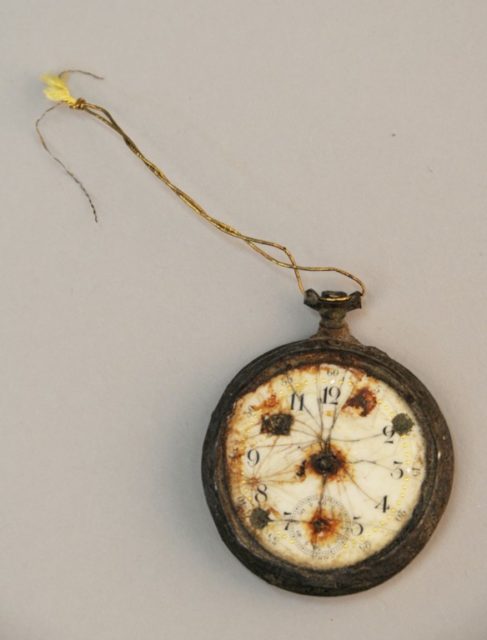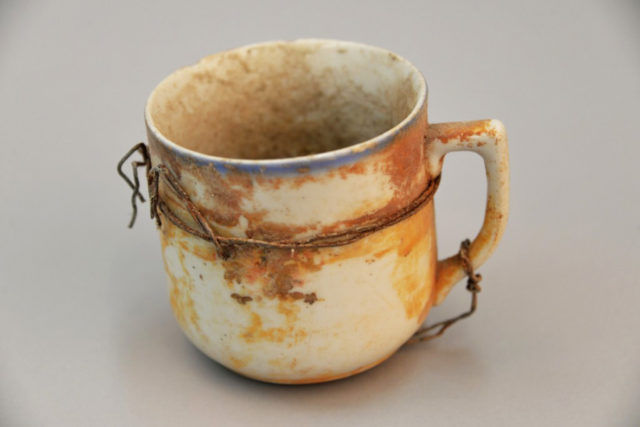During a press conference at the Auschwitz Museum, located in Oswiecim, Poland, personal items that once belonged to the victims of the Nazi extermination regime at the concentration camp Auschwitz-Birkenau were presented to the public.
These artifacts were rediscovered after being stored for forty-eight years at the Polish Academy of Sciences in Warsaw, Poland.
There are about 16,000 of these long-lost objects, including jewelry, watches, brushes, tobacco pipes, lighters, fragments of kitchenware, buttons, Pocketknives, and keys.
One of the most poignant finds is the box of private letters that had been seized by the Germans, as well as the remains of a diary.

These artifacts had been initially found in 1967 by archaeologists when they were excavating the ruins of the camp’s gas chamber and crematorium III. Now, these items have finally been found and returned to the Auschwitz-Birkenau Memorial and Museum, the Agence France-Presse (AFP) reports.
During the press conference, the director of Auschwitz Museum, Piotr Cywinski, said, “I had considered the discovery of such a huge collection in whole after nearly half a century as unlikely as finding the treasure of the lost Galleon.
I can only try to imagine why the lost objects were deposited in these boxes just after digging up.” He continued, explaining the reason for the fate of the boxes.
“The excavations were carried out in the summer of 1967, near the gas chambers and crematoria. Presumably, they were supposed to be analyzed and studied, or perhaps someone even had the intention to write an extensive research paper on the subject.” Cywinski went on to emphasize the uniqueness of the find.
PHOTOS: ‘Long-Lost’ Personal Treasures of Holocaust Gas Chamber Victims Discovered – https://t.co/MlGbQ8m760 pic.twitter.com/uOwZMMN9nh
— First to Know (@BeFirsttoKnow) 9 June 2016
On that subject, a spokesman for the museum, Pawel Sawicki, told MailOnline. “There is almost no personal information on the objects, yet the fact that they were found near the ruins of gas chamber and crematorium III indicates that they belonged to Jews murdered by the German Nazi in the gas chambers.”
He said, “These people were told that they were being resettled and they took their personal belongings with them. The items found were most probably things which they had in their pockets when they were entering the undressing room of the gas chamber.”
For those who are unfamiliar with World War II history, Auschwitz was one of many concentration camps that had been set up by the Third Reich. This particular one opened in 1940, and the first round of prisoners was murdered in September 1941.
It had one of largest populations of all the camps, with the death rate to match. Between 1942 and late 1944, tens of thousands of Jews were killed in the camp’s gas chambers. Although the numbers are estimated, historians agree that at least 1.1 million people died there.
Ripped from their homes all across German-occupied Europe, the prisoners were lined up once they arrived at the camp and the SS split them into two groups: the men who were fit to work, and everyone else who was not.
Those who were deemed unworthy were taken directly to the gas chambers and murdered. The men who could work were pushed until they died.
There were several gas chambers and crematoriums on the camp’s grounds. The artifacts were found at Gas Chamber and Crematorium III, which was put into operation in the summer of 1943. G
as chambers are underground rooms that are covered by a concrete roof and a layer of dirt. The gas (deadly Zyklon-B) was actually in the form of pellets which were poured through a small hole in the roof, after which they would vaporize.
Once the gas had done its work, the victims’ bodies were taken up via a lift to the ground floor where they would be burned in the crematorium.
Gas Chamber and Crematorium III no longer stands — the building was blown up by the Nazis during their flight in January 1945. Days later, the Red Army would liberate the neglected prisoners.
The museum staff first caught a hint at the existence of the artifacts after they viewed an old documentary that depicted the 1967 excavations at the camp.
It took months of searching and many headaches, they finally managed to track down the artifacts. Now, their task is to catalog the entire collection and identify who owned them.

Sawicki commented on the task ahead during an interview. “It will take us a long time to research the whole collection. Right know we will start a process of documenting and researching the items and checking their state of preservation.”
He explained, “Many of them will need conservation. In terms of identifying the owners in most cases, it will not be possible, since there are almost no traces which can lead us to an individual person. Yet, maybe something will be found during the documentation process.”
Despite the hard work ahead, it is a remarkable find, and Cywinski and his staff seem up for the challenge. T
hey have good motivation, too. “The objects found during the works are not only a remarkable testimony to the history of the camp and the extermination conducted by the Germans, but also a moving personal testimony of the victims.”
He explained. “In most cases, these are the last personal belongings of the Jews led to death in the gas chambers upon selection at the ramp.”